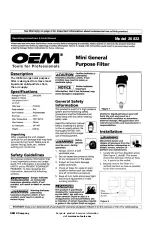
JUDO FIMAT
9
Installation
4.1.1 Transport / Storage
The JUDO FIMAT backwash protective filter
has to be guarded against great shock load.
4.1.2 Requirements for the place of
installation
The room where the unit is installed must
be dry and frost free!
Unauthorised persons must not have
access to the filter!
ATTENTION
(see chapter “Safety information and
dangers due to non-compliance”)
–
The ambient temperature must not
exceed 30 °C (86 °F)! At higher
temperatures or direct sun radiation the
material can be damaged and the filter
hood can even break.
–
In order to be able to safely discharge
the wastewater in operation and in case
of any defects that occur in the system,
precise compliance with the details
given in the “Installation” chapter is
necessary! If the wastewater (back-
washing) cannot be safely and
completely discharged, the house and
installations can be damaged by water.
–
A shut-off valve must be installed
upstream of the filter! This enables the
water supply to the filter to be interrupted
during installation, servicing/mainte-
nance, repairs and in case of malfunc-
tions. Floods and serious water damage
to house installations can therefore be
avoided.
–
The unit can be installed in all standard
drinking water pipes.
–
It is not permitted to install the back-
wash protective filter upstream of the
water meter!
–
A socket outlet with earthing contact, for
the automatic filter's power supply unit,
is required above the backwash protec-
tive filter with a continuous power supply
at a maximum distance of 60 inch
(1.5 m).
4.1.3 Installed position
ATTENTION
(see chapter “Safety information and
dangers due to non-compliance”)
Always install the filter in a vertical position
(± 5°)!
Failure to observe this can cause uncon-
trolled backwashing water to escape and
can result in water damage.
4.1.4 Mounting the built-in rotary
flange
Install using the supplied built-in rotary
flange. The built-in rotary flange is used as a
connecting element between filter and
domestic water installation.
It is suitable for both horizontal and vertical
pipes.
The built-in rotary flange must be in-
stalled in the direction of flow. This is
marked by a cast in arrow (see fig. 3).
Failure to comply with this means the filter
cannot work.
ATTENTION
(see chapter “Safety information and
dangers due to non-compliance”)
The flange surface of the built-in rotary
flange must be in a horizontal position! The
built-in rotary flange must be fitted so that
mechanical stresses cannot occur! Other-
wise mechanical damage can result in the
built-in rotary flange. Otherwise mechanical
Summary of Contents for FIMAT JFXL-M 1 1/2
Page 3: ...JUDO FIMAT 3 ...










































